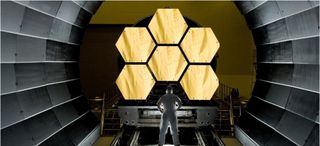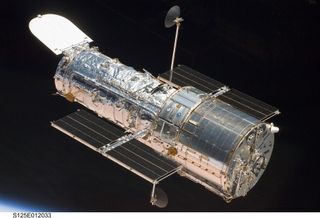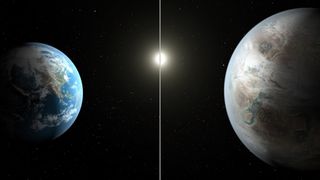Commercial Space to Smash the Astronomy 'Funding Wall'?

What's happening in our universe? In the 400 years since we first started using telescopes, we've been trying to answer this question. The past two decades alone have been dizzying: Planets found outside the solar system, a universe accelerating in its expansion, and hints of the mysterious dark energy and dark matter that make up most of the universe, to name a handful of historic discoveries.
But to see further, we often need to spend big.
RELATED: Covers Off! Say Hello to Our Future Mega-Space Telescope
There's been much coverage of the more than $9 billion James Webb Space Telescope that will launch in 2018, to probe planetary atmospheres and to look back at the universe's beginnings. What will come next? Looking a bit ahead, the astronomy organization AURA suggests a "High Definition Space Telescope" to launch in 2035, an observatory double Webb's size. But how this would be paid for comes under scrutiny in a new report.
Harvard astrophysicist Martin Elvis' new paper in Space Policy to try to solve what he calls the astronomy "funding wall." Our hunger for greater telescopes in X-ray emissions alone, he argues, has made the cost of this mission type increase 20 times in the past generation. (Yes, that's after adjusting for inflation.) Moreover, space missions often go over their budget before launch.
"At some point the costs are more than a government can abide," he wrote. "Particle physics hit its funding wall in the U.S. when the Superconducting Super-Collider, already far along in construction in Texas, went over budget one too many times and was cancelled. Is astronomy next?"

JWST may already be testing the limits, he added. Its cost growth led to repeated threats of cancellation, but the mission has been replanned to try to avoid this. Elvis said that NASA has a budget of just $5 billion per decade for large new space telescopes. "Each JWST-class mission thus takes 100% of nearly 20 years of this funding line," he said, pointing out the successor mission of the Wide-Field Infrared Survey Telescope (WFIRST) could be similar in cost to JWST.
Get the Space.com Newsletter
Breaking space news, the latest updates on rocket launches, skywatching events and more!
What Can Giant Telescopes Teach Us About Our Universe?
He also worries that focusing on a single, large telescope will make NASA's program lose its robustness. Right now we have three "Great Observatories" -- the Hubble Space Telescope, the Spitzer space telescope, and the Chandra X-Ray Observatory -- operating in different wavelengths: visual, infrared and X-ray. We need to study the same object in different wavelengths to properly understand it. The youngest of these telescopes is 13 years old and will eventually fail during JWST's lifetime; JWST is most sensitive in infrared and follow-up observations in X-rays, Elvis argues, would need to wait.
RELATED: Top 10 Astronomical Discoveries Of All Time
But before worrying overmuch, Elvis proposes a solution: to depend more on the commercial space sector. Think about how much it has changed human spaceflight in the last decade. Now we have regular cargo runs to the International Space Station; in SpaceX's case, occasionally these missions have been able to land their rockets for future re-use. And very soon, SpaceX and Boeing will be sending astronauts aloft on their own spacecraft. What is the prospect for astronomy?

He argues that commercial spacecraft (which are more likely to see cost driven down by competition) would see quick advances in a few areas. Costs in launch, spacecraft and payloads would reduce, mainly because we are making a lot of advances today to reduce the mass hefted to orbit. In space, mass is one of the major costs.
"Cutting spacecraft cost by a factor 2, along with launch costs by a factor 3, would roughly halve the cost of a flagship mission," he said. "This would radically alter flagship mission decisions, by doubling the number that could be launched each decade."
RELATED: Can Future Telescopes See The Edge Of The Universe?
Elvis also argues that as private tourists spend time in orbit, the demand would lower the cost for low-Earth orbit missions and provide more access for astronomers. How this would be done still needs to be worked out (the Bigelow module on the space station has no platform for telescopes, for example.) More locations could open up across the solar system with private lunar landers and asteroid prospectors, too.
You can read about these arguments, and Elvis' vision for spaceflight in the 2020s and beyond as we expand across the solar system, in his paper "What can Space Resources do for Astronomy and Planetary Science?"
Originally published on Discovery News.
Join our Space Forums to keep talking space on the latest missions, night sky and more! And if you have a news tip, correction or comment, let us know at: community@space.com.

Elizabeth Howell (she/her), Ph.D., is a staff writer in the spaceflight channel since 2022 covering diversity, education and gaming as well. She was contributing writer for Space.com for 10 years before joining full-time. Elizabeth's reporting includes multiple exclusives with the White House and Office of the Vice-President of the United States, an exclusive conversation with aspiring space tourist (and NSYNC bassist) Lance Bass, speaking several times with the International Space Station, witnessing five human spaceflight launches on two continents, flying parabolic, working inside a spacesuit, and participating in a simulated Mars mission. Her latest book, "Why Am I Taller?", is co-written with astronaut Dave Williams. Elizabeth holds a Ph.D. and M.Sc. in Space Studies from the University of North Dakota, a Bachelor of Journalism from Canada's Carleton University and a Bachelor of History from Canada's Athabasca University. Elizabeth is also a post-secondary instructor in communications and science at several institutions since 2015; her experience includes developing and teaching an astronomy course at Canada's Algonquin College (with Indigenous content as well) to more than 1,000 students since 2020. Elizabeth first got interested in space after watching the movie Apollo 13 in 1996, and still wants to be an astronaut someday. Mastodon: https://qoto.org/@howellspace
